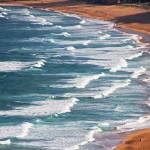Riviera Maya, Mexico – Beach Watch (19.12.15)
The Riviera Maya, running along the Yucatán Peninsula’s east coast between Puerto Morelos and Tulum, has the most idyllic collection of white sand, palm-fringed, bounty-bar-beaches not only in the Americas, but arguably the world.

So magnificent are the beach options that we at Nomadic Thoughts have, over the decades, delighted in updating ourselves on the most recent developments, facilities, hotels and above all, beach options. As I type this blog, with clear turquoise water lapping against the powder-white sand in front of me, I am more than thankful that it is once again my turn for some flat-out research and reconnaissance.
As these images (all of which I snapped this week) show, it is easy to see why so many people (of all ages) are drawn to the Riviera Maya. Whether to celebrate a wedding, walk mile after mile on classic beaches or swim in sky-blue-surf, we at Nomadic Thoughts regard it as the obvious and perfect, ‘white Christmas’ location.

What however, is not quite so obvious is how many different options and delicate local environments there are. The region, already serviced by a wide selection of large, all-inclusive resorts and exciting boutique-style hotels, is set to see tourism development continue at breakneck speed. The true worth of this 135km stretch of coast has been fully understood by the Mexican authorities, who are planning a twenty-year expansion of coastal settlements to accommodate an additional 200,000 people. This of course, will be an environmental issue, not least as this region kisses up against the world’s second largest barrier reef – the Mesoamerican Barrier Reef System.

Visiting the Riviera Maya today I feel mixed emotions. It’s heartening on the one hand, and worrying on the other.
When I travel up and down the coast visiting the old, bold and most beautiful of hotels, beaches and coral reef settings, I am constantly impressed at how clean the local communities and visiting tourists keep the beaches. It is not uncommon to see locals and tourists alike walking down the beach picking up washed-up rubbish. Equally, the early morning sunrise shift sees hotel staff engaged in the clean-up of their local beach as fisherman go about their net setting and dive boats head out towards the flat horizon.

What is worrying however, is that on the larger scale there appears to be an additional threat. Since mid-summer 2014 the whole Caribbean region (from Central American coasts to Florida and the West Indies islands) has experienced an unusual build up of seaweed. Climate change and subsequent shifting currents appear to be the most likely causes. The seaweed (sargassum), usually contained within the north Atlantic, has built up on previously unaffected beaches after a series of weaker hurricane seasons. This has resulted in less Atlantic Ocean seaweed-smashing, and more washed up as debris on the Caribbean coast.

Depositing excess seaweed into beach hole.
The whole region has been affected. While Tobago recently announced a US$3m clean-up operation, Barbados held a Sargassum Convention and Antigua experienced 4ft high seaweed piles. Even the east coast beaches of the Yucatan have been affected, so much so that in July this year the Mexico Environmental Department announced a $9m scheme, aided by 4,600 temporary workers, to clean up the coast. Along the hugely developed Cancun coast, north of the Riviera Maya, for example, over 100 tons of seaweed was removed.
While Mother Nature will decree whether this will be a long term issue, the combination of a caring local community and environmentally conscious tourism industry will have to soldier on with a firm eye on the sustainability of the Riviera Maya’s paradise beaches, blue coral reefs and palm-fringed coastal activities.




Pelicans at dawn.









Riviera Maya wedding party.
















